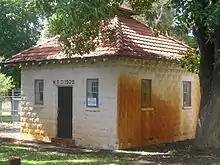Iron(II) hydroxide
Iron(II) hydroxide or ferrous hydroxide is an inorganic compound with the formula Fe(OH)2. It is produced when iron(II) salts, from a compound such as iron(II) sulfate, are treated with hydroxide ions. Iron(II) hydroxide is a white solid, but even traces of oxygen impart a greenish tinge. The air-oxidised solid is sometimes known as "green rust".
_hydroxide.JPG.webp) | |
-hydroxide-3D-vdW.png.webp) | |
| Names | |
|---|---|
| IUPAC name
Iron(II) hydroxide | |
| Other names
Ferrous hydroxide | |
| Identifiers | |
3D model (JSmol) |
|
| ChemSpider | |
| ECHA InfoCard | 100.038.581 |
PubChem CID |
|
| UNII | |
CompTox Dashboard (EPA) |
|
| |
| |
| Properties | |
| Fe(OH)2 | |
| Molar mass | 89.86 g/mol |
| Appearance | green solid |
| Density | 3.4 g/cm3 [1] |
| 0.000052 g/100 g water (20 °C, pH 7)[2] | |
Solubility product (Ksp) |
8.0 x 10−16[3] |
| Hazards | |
| Flash point | Non-flammable |
| Related compounds | |
Related compounds |
Iron(II) oxide Iron(III) hydroxide |
Except where otherwise noted, data are given for materials in their standard state (at 25 °C [77 °F], 100 kPa). | |
| Infobox references | |
Preparation and reactions
Iron(II) hydroxide is poorly soluble in water (1.43 × 10−3 g/L), or 1.59 × 10−5 mol/L. It precipitates from the reaction of iron(II) and hydroxide salts:[4]
- FeSO4 + 2NaOH → Fe(OH)2 + Na2SO4
If the solution is not deoxygenated and the iron reduced, the precipitate can vary in colour starting from green to reddish brown depending on the iron(III) content. Iron(II) ions are easily substituted by iron(III) ions produced by its progressive oxidation.
It is also easily formed as a by-product of other reactions, a.o., in the synthesis of siderite, an iron carbonate (FeCO3), if the crystal growth conditions are imperfectly controlled.
Structure
Fe(OH)2 is a layer double hydroxide (LDH).
Related materials
Green rust is a recently discovered mineralogical form. All forms of green rust (including fougerite) are more complex and variable than the ideal iron(II) hydroxide compound.
Reactions
Under anaerobic conditions, the iron(II) hydroxide can be oxidised by the protons of water to form magnetite (iron(II,III) oxide) and molecular hydrogen. This process is described by the Schikorr reaction:
- 3 Fe(OH)2 → Fe3O4 + H2 + 2 H2O
Anions such as selenite and selenate can be easily adsorbed on the positively charged surface of iron(II) hydroxide, where they are subsequently reduced by Fe2+. The resulting products are poorly soluble (Se0, FeSe, or FeSe2).
Iron(II) hydroxide has also been investigated as an agent for the removal of toxic selenate and selenite ions from water systems such as wetlands. The iron(II) hydroxide reduces these ions to elemental selenium, which is insoluble in water and precipitates out.[5]
In a basic solution iron(II) hydroxide is the electrochemically active material of the negative electrode of the nickel-iron battery.
Natural occurrence

Iron dissolved in groundwater is in the reduced iron II form. If this groundwater comes in contact with oxygen at the surface, e.g. in natural springs, iron II is oxidised to iron III and forms insoluble hydroxides in water.[6]
The natural analogue of iron(II) hydroxide compound is the very rare mineral amakinite, (Fe,Mg)(OH)
2.[7][8]
See also
References
- Lide, David R., ed. (2006). CRC Handbook of Chemistry and Physics (87th ed.). Boca Raton, FL: CRC Press. ISBN 0-8493-0487-3.
- CRC Handbook of Chemistry and Physics, 84th Edition, CRC Press, 2004, pg 4-62
- http://www.gfredlee.com/SurfaceWQ/StummOxygenFerrous.pdf
- H. Lux "Iron(II) Hydroxide" in Handbook of Preparative Inorganic Chemistry, 2nd Ed. Edited by G. Brauer, Academic Press, 1963, NY. Vol. 1. p. 1498.
- Zingaro, Ralph A.; et al. (1997). "Reduction of oxoselenium anions by iron(II) hydroxide". Environment International. 23 (3): 299–304. doi:10.1016/S0160-4120(97)00032-9.
- lenntech.com
- https://www.mindat.org/min-180.html
- https://www.ima-mineralogy.org/Minlist.htm